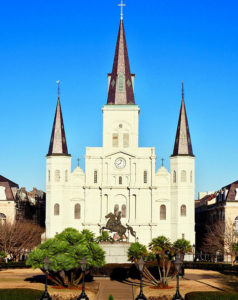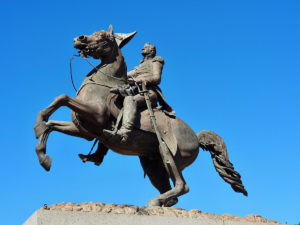Do you know… New Orleans is often called Vieux Carré?
Originally the area of Jackson Square was nothing more than a trading camp where French voyageurs met to exchange goods with Indians and other traders traveling along the Mississippi River. During those early years it was not a wonderful place to live. The following is a description of the area:
Twas a place of a hundred wretched hovels in a malarious wet thicket of palmettos infested by serpents and alligators. Much of the colonial population was of the wildest and most undesirable characters including deported galley slaves, trappers and gold hunters.
 New Orleans was officially founded in 1718. A few years later a landscape architect from France organized the chaotic settlement into a formal colony by sketching a layout inspired by the oldest square in Paris called Place des Vosges. This one block common area was designed to be used as a military parade ground and an open-air market. It became the heart of everyday life, the point of shipping and the site for public executions. This lovely square for more than a century was under the French flag as the Placed’Armes or Weapons Square.
New Orleans was officially founded in 1718. A few years later a landscape architect from France organized the chaotic settlement into a formal colony by sketching a layout inspired by the oldest square in Paris called Place des Vosges. This one block common area was designed to be used as a military parade ground and an open-air market. It became the heart of everyday life, the point of shipping and the site for public executions. This lovely square for more than a century was under the French flag as the Placed’Armes or Weapons Square.
Over the years, as the colony grew the residents called the square Vieux Carré (Via Car’ray) which translated means “Old Square.” Its name officially changed to Plaza de’Armas when Spain controlled the colony. But the folks still called their square, with it iron fences, walkways, benches and Parisian-style landscaping remaining intact, Vieux Carré. The French took over the city again until 1803 when the United States made a deal with France called the Louisiana Purchase. The flagpole in the square symbolizes the 1803 ceremonial transfers from Spain to France and then from France to the United States, reflecting Louisiana’s rich colonial history.
 It was in 1815, near the end of the war of 1812 with the British, that the two sides met in what is remembered as one of the conflict’s biggest and most decisive engagements… the bloody Battle of New Orleans. Future President, but then General Andrew Jackson and a motley assortment of militia fighters, frontiersmen, slaves, Indians and even pirates weathered a brutal frontal assault by a superior British force, while inflicting devastating casualties. Jackson only lost a handful of men in the battle. The victory vaulted Jackson to national stardom, foiled plans for other British invasions of the American frontier and this square was renamed in his honor, as Jackson Square.
It was in 1815, near the end of the war of 1812 with the British, that the two sides met in what is remembered as one of the conflict’s biggest and most decisive engagements… the bloody Battle of New Orleans. Future President, but then General Andrew Jackson and a motley assortment of militia fighters, frontiersmen, slaves, Indians and even pirates weathered a brutal frontal assault by a superior British force, while inflicting devastating casualties. Jackson only lost a handful of men in the battle. The victory vaulted Jackson to national stardom, foiled plans for other British invasions of the American frontier and this square was renamed in his honor, as Jackson Square.
Placed in the center in of the old square in 1856 is the dramatic statue of General Andrew Jackson on his rearing horse. The work is of sculptor Clark Mills. It is the world’s first equestrian statue with more than one hoof unsupported. Another casting of the statue in front of the White House in Washington DC is cast from seized British cannon balls from that War of 1812.
While the official name of the square has changed and the city grew well beyond its original boarders the Old Square, Vieux Carré, remains both a symbol and the heart of New Orleans. So now you know!
The best way to fully experience the French Quarter is by using the SelfTour™ GPS guided walking tour App on your smartphone. Check out our French Quarter Tour.



